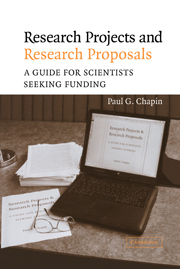Book contents
- Frontmatter
- Contents
- Foreword
- Acknowledgments
- Introduction
- 1 Selecting a Research Topic
- 2 Project Planning
- 3 Identifying Funding Sources
- 4 Special Funding Mechanisms
- 5 Writing a Proposal
- 6 Research Ethics and Responsibilities
- 7 The Natural History of a Proposal
- 8 “We Are Happy/Sorry to Inform You …”
- 9 Managing Your Grant
- Appendix A Glossary of Acronyms
- Appendix B Useful URLs
- Index
5 - Writing a Proposal
Published online by Cambridge University Press: 14 July 2009
- Frontmatter
- Contents
- Foreword
- Acknowledgments
- Introduction
- 1 Selecting a Research Topic
- 2 Project Planning
- 3 Identifying Funding Sources
- 4 Special Funding Mechanisms
- 5 Writing a Proposal
- 6 Research Ethics and Responsibilities
- 7 The Natural History of a Proposal
- 8 “We Are Happy/Sorry to Inform You …”
- 9 Managing Your Grant
- Appendix A Glossary of Acronyms
- Appendix B Useful URLs
- Index
Summary
All right. Now that you've selected your topic, planned your project, and identified your potential funding sources, it's time to sit down and actually write your proposal. In this chapter, we'll describe a way to approach the job that should make it easier and make the result more effective.
The model informing the discussion here will be a proposal to the NSF. Most of what we say will be at a level that is general enough to apply to proposals to other agencies as well, but those may have special features that we won't deal with here. It's important to get specific guidance from the agency you're applying to, from its Web site and from a program officer in your area, to supplement the help this book provides.
The Audience
The first question to consider when you set out to write anything, proposals included, is “who is the audience?” When you know who is in your audience, and how they think, and what they expect, you're in a position to communicate your message to them confidently and effectively.
The audience for a research proposal has up to three major components. These go by different names at different agencies, but at NSF they are known as ad hoc reviewers, advisory panels, and program officers. At least one program officer will always be involved; ad hoc reviewers, or panels, or both, may also participate, depending on the type of proposal and what part of the agency is reviewing it.
- Type
- Chapter
- Information
- Research Projects and Research ProposalsA Guide for Scientists Seeking Funding, pp. 61 - 97Publisher: Cambridge University PressPrint publication year: 2004



